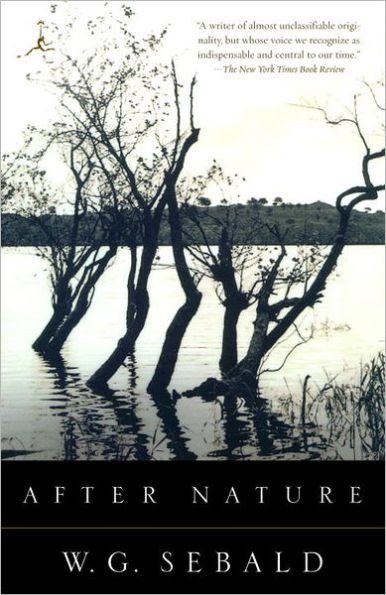After Nature, W. G. Sebald’s first literary work, now translated into English by Michael Hamburger, explores the lives of three men connected by their restless questioning of humankind’s place in the natural world. From the efforts of each, “an order arises, in places beautiful and comforting, though more cruel, too, than the previous state of ignorance.” The first figure is the great German Re-naissance painter Matthias Grünewald. The second is the Enlightenment botanist-explorer Georg Steller, who accompanied Bering to the Arctic. The third is the author himself, who describes his wanderings among landscapes scarred by the wrecked certainties of previous ages.
After Nature introduces many of the themes that W. G. Sebald explored in his subsequent books. A haunting vision of the waxing and waning tides of birth and devastation that lie behind and before us, it confirms the author’s position as one of the most profound and original writers of our time.
From the Hardcover edition.
1102391951
After Nature introduces many of the themes that W. G. Sebald explored in his subsequent books. A haunting vision of the waxing and waning tides of birth and devastation that lie behind and before us, it confirms the author’s position as one of the most profound and original writers of our time.
From the Hardcover edition.
After Nature
After Nature, W. G. Sebald’s first literary work, now translated into English by Michael Hamburger, explores the lives of three men connected by their restless questioning of humankind’s place in the natural world. From the efforts of each, “an order arises, in places beautiful and comforting, though more cruel, too, than the previous state of ignorance.” The first figure is the great German Re-naissance painter Matthias Grünewald. The second is the Enlightenment botanist-explorer Georg Steller, who accompanied Bering to the Arctic. The third is the author himself, who describes his wanderings among landscapes scarred by the wrecked certainties of previous ages.
After Nature introduces many of the themes that W. G. Sebald explored in his subsequent books. A haunting vision of the waxing and waning tides of birth and devastation that lie behind and before us, it confirms the author’s position as one of the most profound and original writers of our time.
From the Hardcover edition.
After Nature introduces many of the themes that W. G. Sebald explored in his subsequent books. A haunting vision of the waxing and waning tides of birth and devastation that lie behind and before us, it confirms the author’s position as one of the most profound and original writers of our time.
From the Hardcover edition.
4.99
In Stock
5
1

After Nature
128
After Nature
128Related collections and offers
4.99
In Stock

Product Details
| ISBN-13: | 9780307813657 |
|---|---|
| Publisher: | Random House Publishing Group |
| Publication date: | 12/07/2011 |
| Sold by: | Random House |
| Format: | eBook |
| Pages: | 128 |
| Sales rank: | 777,059 |
| File size: | 2 MB |
About the Author
From the B&N Reads Blog
